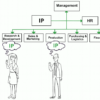Patentability of digital business models: The 6th module of the MIPLM
New developments in digital technologies have led to the emergence of new business models that potentially challenge the present stand of many industries. The business models of enterprises such as Netflix or Tencent have already created measurable changes for their industries based on their IP strategies. During this last module of the Master of Intellectual Property Law and Management (MIPLM) at CEIPI, we analyzed the relevant IP strategies which are applied in different industries to create successful new business models like digital platforms. These businesses operate a virtual marketplace that match two independent customer groups to enable commercial transactions. Today, we see hundreds of such digital marketplace business models.
In the last years, the concept of digital transformation reached a solid and high position in strategic discussions across industries: it is about the survival of contemporary organizations. Digital transformation can be defined as the modification and adaptation of business models, resulting from the dynamic pace of technological progress and innovation that triggers changes in consumer and competitor behaviors. The driving forces of the transformation are several key technologies that started gathering the critical mass of usage, enormous investments in innovative enterprises, and rapid onboarding of technological tools by consumers and businesses. The 6th module of the MIPLM-Program is about IP in business development for digital business models.
The discussion started with the differentiation of business model and strategy. We developed a multidimensional view on the core concepts of business models: the architecture which gives answer to the two most important questions: Who is the customer and what does the customer value? We used for that the most common framework which was proposed by Osterwalder and Pigneur in the form of a “business model canvas” (BMC).
Cannot open the video? Please click: https://youtu.be/QoAOzMTLP5s
The authors worked with 470 practitioners in 45 countries to gather all core elements of a business model in a single view. The resulting “canvas” contains the following components: key partners, key activities, key resources, value propositions, customer relationships, channels, customer segments, cost structures, and revenues.
The relative simplicity behind the BMC provides support for quick and efficient content documentation in the process of identifying crucial components of an organization. The BMC can be adopted to reflect the digital transformation of the business model of an organization. The digital transformation of new entities and relationships are driven by the application of information technology. Information technology can be seen as an enabler of changes to the classical paradigms of organizations.

SOURCE: KOTARBA, MARCIN, DIGITAL TRANSFORMATION OF BUSINESS MODELS, FOUNDATIONS OF MANAGEMENT, 10 (2018) P. 127
Intellectual Property (IP) offers a way to protect oneself in digitally transforming business eco-systems. If one succeeds in owning a legally enforceable exclusivity for a customer’s benefit in one’s own range of services, then premium prices can be enforced, and market positions can be shaped in digital business models. How to proceed is determined by the 360 degree IP strategy. In workshops we discussed this practice-oriented method for SMEs and tools to expand and secure the technical advantage over the competitors in the long term.
Comprehensive digitalization involves the potential for disruptive changes to the business models of companies. Especially in recent years, companies such as Amazon, Uber and Mister Spex have demonstrated with their digital business model innovations how the rules of competition and industry structures can fundamentally change within a very short period of time. Digital business model innovations, however, are relevant not only for former start-ups and digital pioneers. They also offer new opportunities to established companies that will enable them to expand their business activity. For example, Daimler, the automobile manufacturer, founded car2go, a car-sharing service that allows users to book a reservation using a smartphone app and which today is the market leader in flexible car-sharing.

SOURCE: KOTARBA, MARCIN, DIGITAL TRANSFORMATION OF BUSINESS MODELS, FOUNDATIONS OF MANAGEMENT, 10 (2018) P. 128
The successful implementation of digital business models is primarily dependent on management decisions. In this context controllers, in their capacity as business partners of management, must adequately support decision-makers regarding digital innovation issues. When analyzing in depth the supportive role played by IP managers, it is important to distinguish between two key perspectives: First, IP management supports the process by acting as an enabler for the development of digital business model innovations, and second, the implementation of such business model innovations must be seen as a driver for making changes to IP management itself. This perspective as an enabler means that the IP manager provides support for the phases of innovation, specifically “brainstorming”, “assessing ideas”, “implementation” and “ongoing operations”. From an IP management perspective, brainstorming means, for example, determining how products and services can be priced in the context of a business model innovation, determining which markets to develop, or forecasting revenue growth. Assessing an idea involves determining what value the digital business model innovation will contribute to the company’s success. The focus of the implementation phase is on the design of a performance management system for IP that is suitable for digital business models. As soon as the digital business model innovation has been established, the IP manager must then track the IP associated revenues and costs in a management profit reporting that is appropriate for ongoing operations. The second perspective focuses on the digital transformation of IP management itself. A complete, transformative approach involves four fundamental areas of activity: processes and structures, methods and tools, roles and identity, and capabilities and cooperation.
The MIPLM was again supported by co-examiners from the industry and private practice. This years examination board was Florian Adt (Mercedes), Dr. Ari Hirvonen (Outokumpu), Dr. Hannes Burger (ABP), Lars-Frederik Urang (Onsagers), Prof. Dr. Alexander Wurzer (CEIPI), Dr. Thibaud Lelong (CEIPI) (from left to right). Thanks to all participants of the 2021-2022 MIPLM and good luck for the thesis defenses on 22.09.2022:





